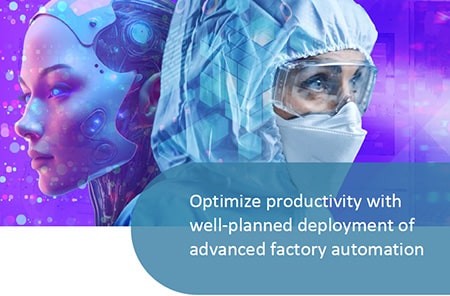Chip manufacturing information is rich and complex, and bringing this information together has substantial benefits. Data variety, sources, quality, and volume are some of the characteristics which make this task challenging. SmartFactory has built a unified process control (UPC) solution that brings together in one platform the different principles of process quality, specifically pertaining to monitoring product. The unified platform takes data from multiple sources that speak a different language and, for the first time, transports them into composite data to have more insights into the factory.
We chose to build the solution on the Applied E3® equipment and process control platform, which has all the core capabilities and is something most customers already use. The resulting ecosystem provides models and linkages to E3 that make it possible to move to automated decision making (AI-enabled decisions) for process quality.
The UPC derives artifacts from many pieces of equipment rather than looking at data in a silo. This is key, since there are implications for process quality coming from each of those different artifacts, and looking at them holistically provides deeper insights. The solution brings together relevant data from multiple sources, looks at it in a combined fashion and interprets what happened, what needs to be done and how. Its interpretive vision identifies an accident as well as the specific, combined effects that led to the problem, then tells you what to fix and how.
SmartFactory’s unified platform was designed with only the required resources to provide insights, carefully filtering noise that wouldn’t have an impact on process quality. Importantly, the solution does not take a cookie-cutter approach. Because the models must be reliable and relatable to the individual semiconductor factory, they are designed one-by-one. The user can input information specific to the factory, as well as identify protocol for managing situations.
Take for example, a factory where many alarms have come from the same source in a short period of time. Each is fixed in turn, but the source continues to trigger alarms. In the fast-paced environment, manufacturers can’t afford to stop production to analyze this extensively. Fixing each alarm’s perceived cause is a band aid approach to get back to production, but it clearly isn’t working. In this case, the UPC does the work without interrupting production. It looks at the history of that source over several different shifts to see that it’s a recurring problem. The model gathers and interprets data across several shifts, looking at multiple factors that may impact process quality. It integrates the artifacts, reads relationships between them, and finds the root cause of the alarms, finally proposing a remedy.
In this way, manufacturers can make business decisions faster. Additionally, the model becomes a continuous improvement tool. Once it has identified the solution to one problem, it can move on to other process quality concerns to analyze combined data toward another solution.
This connectivity via a unified platform can help you unleash the full potential of your fab by harnessing the synergy of integrated tools and data to simplify operations and empower your teams.
Information created in the process of chip manufacturing is rich and complex, derived from several sources in the factory. Bringing this information together has substantial benefits. Data variety, sources, quality, and volume are some of the characteristics that make this task challenging. Here, we’ll look at how SmartFactory can help overcome that challenge.
Our solution
How does Unified Process Control work?
The unified platform takes data from multiple sources that speak a different language and, for the first time, transports them into composite data to have more insights into the semiconductor factory. This integration at a core level across all process control systems requires:
- A standardized data structure, which is critical for advanced analysis and AI/ML applications
- Shared tools to help standardize our action and reaction to events
- A consistent UI which provides the same look and feel across applications
- Universal management to streamline the administration of the applications
- A standardized knowledge base that enables us to reuse expertise and lower the overall investment
- Architecture designed to scale as factories grow
(For more about the requirements and benefits of unifying process control, see our blog on the topic.)
AI-ready ecosystem
Breaking down silos
The UPC derives artifacts from many pieces of equipment rather than looking at data in a silo. This is key, since there are implications for process quality coming from each of those different artifacts, and looking at them holistically provides deeper insights. The solution brings together relevant data from multiple sources, looks at it in a combined fashion and interprets what happened, what needs to be done and how.
Its interpretive vision identifies an accident and the specific, combined effects that led to the problem. It then tells you what to fix and how.
Solutions unique to each factory
SmartFactory’s unified platform was designed with only the required resources to provide insights, carefully filtering noise that wouldn’t have an impact on process quality.
Importantly, the solution does not take a cookie-cutter approach. Because the models must be reliable and relatable to the individual semiconductor factory, they are designed one-by-one. The user can input information specific to the factory, as well as identify protocols for managing situations.
Fixing without interrupting
Take for example, a factory where many alarms have come from the same source in a short period of time. Each is fixed in turn, but the source continues to trigger alarms. In the fast-paced environment, manufacturers can’t afford to stop production to analyze this extensively. Fixing each alarm’s perceived cause is a band aid approach to get back to production, but it clearly isn’t working.
In this case, the UPC does the work without interrupting production. It looks at the history of that source over several different shifts to see that it’s a recurring problem. The model gathers and interprets data across several shifts, looking at multiple factors that may impact process quality. It integrates the artifacts, reads relationships between them, and finds the root cause of the alarms, finally proposing a remedy. In this way, manufacturers can make business decisions faster.
Bigger picture
Conclusion
FAQs
What is Applied E3?
This advanced equipment and process control solution is a comprehensive factory automation software package designed to improve productivity and reduce costs in semiconductor manufacturing. Utilizing proprietary algorithms, the Applied E3 system can boost process capability by greater than 30%, reduce unscheduled down time, and shorten cycle time to achieve up to a 20% increase in overall equipment effectiveness. The Applied E3 system uniquely integrates all critical equipment automation and process control components to deliver the most flexible, user-friendly and powerful fab-wide Equipment Engineering System solution on the market today.
Where can Unified Process Control get its data from?
How does Unified Process Control impact my team?
The UPC can provide shared access across team members, improving communication and collaboration. For example, engineers responsible for different aspects of production can more easily review combined data, rather than just data specific to their purview. This enables collaboration between different teams to develop a solution to an event.


